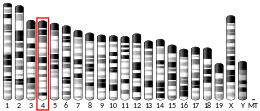SH3BGRL3
SH3 domain-binding glutamic acid-rich-like protein 3 is a protein that in humans is encoded by the SH3BGRL3 gene.[5]
| SH3BGRL3 | |||||||||||||||||||||||||||||||||||||||||||||||||||
|---|---|---|---|---|---|---|---|---|---|---|---|---|---|---|---|---|---|---|---|---|---|---|---|---|---|---|---|---|---|---|---|---|---|---|---|---|---|---|---|---|---|---|---|---|---|---|---|---|---|---|---|
 | |||||||||||||||||||||||||||||||||||||||||||||||||||
| |||||||||||||||||||||||||||||||||||||||||||||||||||
| Identifiers | |||||||||||||||||||||||||||||||||||||||||||||||||||
| Aliases | SH3BGRL3, HEL-S-297, SH3BP-1, TIP-B1, SH3 domain binding glutamate rich protein like 3 | ||||||||||||||||||||||||||||||||||||||||||||||||||
| External IDs | OMIM: 615679 MGI: 1920973 HomoloGene: 41824 GeneCards: SH3BGRL3 | ||||||||||||||||||||||||||||||||||||||||||||||||||
| |||||||||||||||||||||||||||||||||||||||||||||||||||
| |||||||||||||||||||||||||||||||||||||||||||||||||||
| |||||||||||||||||||||||||||||||||||||||||||||||||||
| |||||||||||||||||||||||||||||||||||||||||||||||||||
| |||||||||||||||||||||||||||||||||||||||||||||||||||
| Wikidata | |||||||||||||||||||||||||||||||||||||||||||||||||||
| |||||||||||||||||||||||||||||||||||||||||||||||||||
The 10.5kDa protein SH3 binding glutamic acid-rich protein-like 3 has an isoelectric point of 5.0. SH3 binding glutamic acid-rich (SH3BGR) gene is located to human chromosome 21. Two homologous genes, SH3BGRL and SH3BGRL3 are located to chromosome Xq13.3 and 1p34.3-35, respectively and code for small proteins similar to the N-terminal region of the SH3BGR protein.[6] SH3BGRL3 protein shows a significant similarity to glutaredoxin 1 of E. coli, and all the three proteins are predicted to belong to thioredoxin-like protein family. Glutaredoxins (GRXs) are ubiquitous oxidoreductases, which catalyze the reduction of many intra-cellular protein disulfides and play an important role in many redox pathways. However, the SH3BGRL3 protein lacks the enzymatic function of glutaredoxins and may have a role as a regulator of redox activity.[7]
Role in cancer
Proteins such as glutaredoxin and thioredoxin are reported as up-regulated in many cancers such as lung and pancreatic; they have been implicated in increased resistance of cancer cells to free-radicals. There is little current evidence which directly links SH3GRPL3 with survival in cancer cells, however the protein has recently been identified as up-regulated in glioblastoma multiforme compared to normal cerebral tissue on proteomic analysis.[8] Studies of acute promyelocytic leukemia cell line NB4 have also reported up-regulation of the protein. Conversely, the related protein SH3BGRL is reported to be downregulated in fibroblasts, lymphoid cells, and splenic tumor cells transformed by the viral oncogene v-Rel.[9] Co-expression of SH3BGRL with v-Rel in primary splenic lymphocytes reduced the number of colonies formed by 76%. Xu et al. reported SH3BGRPL3 protein as a post-translational modification of the 27kDa tumor necrosis factor alpha (TNF-α) inhibitory protein, TIP-B1. This protein is potentially involved in resistance of cells to the apoptosis-inducing effect of TNF-α.[10]
References
- GRCh38: Ensembl release 89: ENSG00000142669 - Ensembl, May 2017
- GRCm38: Ensembl release 89: ENSMUSG00000028843 - Ensembl, May 2017
- "Human PubMed Reference:". National Center for Biotechnology Information, U.S. National Library of Medicine.
- "Mouse PubMed Reference:". National Center for Biotechnology Information, U.S. National Library of Medicine.
- "Entrez Gene: SH3BGRL3 SH3 domain binding glutamic acid-rich protein like 3".
- Egeo A, Mazzocco M, Arrigo P, Vidal-Taboada JM, Oliva R, Pirola B, Giglio S, Rasore-Quartino A, Scartezzini P (June 1998). "Identification and characterization of a new human gene encoding a small protein with high homology to the proline-rich region of the SH3BGR gene". Biochem. Biophys. Res. Commun. 247 (2): 302–6. doi:10.1006/bbrc.1998.8763. PMID 9642120.
- Mazzocco M, Maffei M, Egeo A, Vergano A, Arrigo P, Di Lisi R, Ghiotto F, Scartezzini P (May 2002). "The identification of a novel human homologue of the SH3 binding glutamic acid-rich (SH3BGR) gene establishes a new family of highly conserved small proteins related to Thioredoxin Superfamily". Gene. 291 (1–2): 233–9. doi:10.1016/S0378-1119(02)00602-9. PMID 12095696.
- Khalil AA, James P (February 2007). "Biomarker discovery: a proteomic approach for brain cancer profiling". Cancer Sci. 98 (2): 201–13. doi:10.1111/j.1349-7006.2007.00374.x. PMID 17233837.
- Majid SM, Liss AS, You M, Bose HR (February 2006). "The suppression of SH3BGRL is important for v-Rel-mediated transformation". Oncogene. 25 (5): 756–68. doi:10.1038/sj.onc.1209107. PMID 16186799.
- Xu C, Zheng P, Shen S, Xu Y, Wei L, Gao H, Wang S, Zhu C, Tang Y, Wu J, Zhang Q, Shi Y (May 2005). "NMR structure and regulated expression in APL cell of human SH3BGRL3". FEBS Lett. 579 (13): 2788–94. doi:10.1016/j.febslet.2005.04.011. PMID 15907482.
Further reading
- Xu C, Zheng P, Shen S, et al. (2005). "NMR structure and regulated expression in APL cell of human SH3BGRL3". FEBS Lett. 579 (13): 2788–94. doi:10.1016/j.febslet.2005.04.011. PMID 15907482.
- Gerhard DS, Wagner L, Feingold EA, et al. (2004). "The status, quality, and expansion of the NIH full-length cDNA project: the Mammalian Gene Collection (MGC)". Genome Res. 14 (10B): 2121–7. doi:10.1101/gr.2596504. PMC 528928. PMID 15489334.
- Strausberg RL, Feingold EA, Grouse LH, et al. (2003). "Generation and initial analysis of more than 15,000 full-length human and mouse cDNA sequences". Proc. Natl. Acad. Sci. U.S.A. 99 (26): 16899–903. Bibcode:2002PNAS...9916899M. doi:10.1073/pnas.242603899. PMC 139241. PMID 12477932.
- Mazzocco M, Arrigo P, Egeo A, et al. (2001). "A novel human homologue of the SH3BGR gene encodes a small protein similar to Glutaredoxin 1 of Escherichia coli". Biochem. Biophys. Res. Commun. 285 (2): 540–5. doi:10.1006/bbrc.2001.5169. PMID 11444877.
- Henn AD, Berleth ES, Mihich E, Ehrke MJ (2001). "Changes in cytosolic and membrane TNF inhibitory protein-B1 (TIP-B1) levels associated with protection from TNF-induced cytotoxicity". FASEB J. 15 (7): 1315–7. doi:10.1096/fj.00-0543fje. PMID 11344125. S2CID 11425834.
- Seo J, Kim M, Kim J (2001). "Identification of novel genes differentially expressed in PMA-induced HL-60 cells using cDNA microarrays". Mol. Cells. 10 (6): 733–9. doi:10.1007/s10059-000-0733-x. PMID 11211881. S2CID 10539699.
- Berleth ES, Henn AD, Gurtoo HL, et al. (2001). "A novel tumor necrosis factor-alpha inhibitory protein, TIP-B1". Int. J. Immunopharmacol. 22 (12): 1137–42. doi:10.1016/S0192-0561(00)00071-0. PMID 11137621.
- Berleth ES, Nadadur S, Henn AD, et al. (1999). "Identification, characterization, and cloning of TIP-B1, a novel protein inhibitor of tumor necrosis factor-induced lysis". Cancer Res. 59 (21): 5497–506. PMID 10554026.







